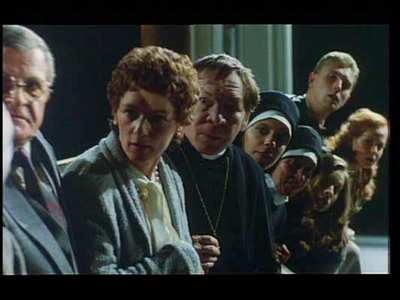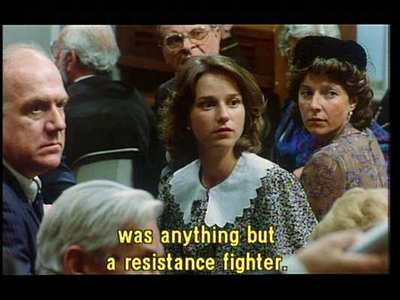Review of Nasty Girl, The
Introduction
Nazi Germany. Just the phrase evokes bitterness of those who lived through the Second World War and suffered at the hands of this regime. War veterans and holocaust survivors alike have stories to tell of brutality and inhumanity, but what of those Germans who lived through the Nazi years as ordinary German citizens. What did they do or see? What actually happened in these towns and villages, and how complicit were they in the pro-Aryan atmosphere generated by the National Socialist party from Berlin? This film from Michael Verhoeven tackles the subject of how a small Bavarian town tries to hide it`s past and the bravery of a young schoolgirl in her attempt to unlock the truth.
Sonja (Lena Stolze) is a young German girl living in Pfilzing, a town in Bavaria. Brought up within a very conservative family and attending a strict convent school, Sonja finds she has a talent for writing. The Federal President initiates a writing essay on the freedoms of Europe, which Sonja`s teacher believes the young girl has a chance of winning. Thus Sonja treks off to the town archives to do some research and talks to the town`s dignitaries in order to get an adult perspective. Sonja wins the contest, winning the first prize of a trip to France, and also becomes a town celebrity for her efforts.
Within a year or two, the Federal President sets another competition with two subjects to be written about. Encouraged to enter again, Sonja chooses what turns out to be the more contentious subject with the purest of motives. The subject `My Town During the Third Reich` inspires Sonja to write an essay that will back up local folklore on the town`s role as a centre of resistance against the Nazi regime, particularly the role of the local church. On one of her trips to the archives, she makes a disturbing discovery in a copy of an old newspaper from 1936 and suddenly finds the town authorities blocking her way. Undeterred, and curious about the apparent cover-up, she relentlessly drives forward in her quest for the truth in spite of the clear anger of local residents and the effect on her family.

Video
A mix of both colour and black & white footage used during this film, the latter to signify the heroine`s early years up until she reached her teens. The picture is still in good condition for a film released around 15 years ago.

Audio
Nice subdued soundtrack of organ and piano music. Dialogue is in German with subtitles in English.

Features
Theatrical trailer - quite long, slow moving and gives away too much.
An interview with director Michael Verhoeven - this is quite interesting with him explaining that although based on a true story, he didn`t want to make his film autobiographical. His reasoning for this was to attempt to show that this kind of story could happen anywhere in Germany.

Conclusion
I have to admit that I was expecting quite a conventional film here, albeit with a very interesting and current plotline. It may be deliberate, or just one of those co-incidences that place media pieces in the right place at the right time, but the release of this film during the 60th anniversary of the liberation of Auschwitz makes this a relevant and poignant film.
The style and tone of the film makes this story easier to digest, whilst the visual tricks from director Michael Verhoeven allow you to see his intention and digest the issues at stake rather than just get sucked into the story. Although a serious and true story, Verhoeven scripts this film as a farce with lots of humour and exaggerated acting. He also mixes visual styles throughout the length of the film so you never get the impression you are watching a normal film.
There are four styles used here:
1. A mock documentary style where the heroine and other characters speak directly into the camera as if being interviewed, with mic boom clearly visible.
2. Realistic filming as per a normal film/drama, some with narration over the top.
3. Mock theatrical stage pieces where you have stage set-ups with what looks like rear projection (although the director clearly explains this technique in the interview for how it is really achieved)
4. A removal of the four walls where a crucial scene is clearly played out on the back of a trailer whilst being towed around a town square on a busy market day.
This complete mixture of styles throughout the film along with the exaggerated acting allows you to step back and examine the motivations of the various characters and how they all fit into the story. Most of the time it is how I would imagine a good theatrical production would work (not a big theatre fan myself…), and this makes the film stand out that little bit more from a straightforward drama.
Lena Stolze plays the heroine Sonja convincingly both as a child and an adult, and the supporting cast around her are very good. The story is based on the current life works of Anna Rasmus, a young girl from Passau who discovered that her hometown was a hotbed of Nazi sympathy with a network of concentration camps around it in the same way as Sonja does here. The film`s narrative follows the true story quite closely in terms of her life, family and the events she both investigated and found herself caught up in. There is some dramatic licence taken with the original story, as explained by the director, but that is to be expected with a story such as this.
It is clear that in the aftermath of any evil dictatorship like the Nazi regime the local inhabitants will be keen to cover up or deny any involvement that either shames them or disgusts anyone examining the facts too closely. There can be a myriad of reasons why such cover-ups can happen, lots of people with different motivations coming together for a common cause. The discovery of the truth then, can bring out the nasty side of people in the fear that either their complicity has been discovered or afraid that their motivations will not be believed.
This film tries to show that the cover-up of involvement by ordinary German people has happened and is still happening. This is a powerful message to bring during a period of time where we remember what happened during the days of the Holocaust. The film mentions the existence of a local concentration camp but doesn`t really expand on it, as the focus is not so much about any concentration camp but more the behaviour of local dignitaries and citizens. There is certainly a story to be written still about the former, but it would just distract from the core story in this film.
It is surprising to find the film quite light-hearted in tone for such a serious message, but this actually helps you to get to grips with the core message rather than get bogged down in detail, heavy dialogue and over-dramatic soundtrack scores. I can appreciate that this film is not for everyone either in terms of storyline or style, but I really enjoyed this film all the way to its quite shocking ending.
Your Opinions and Comments
Be the first to post a comment!